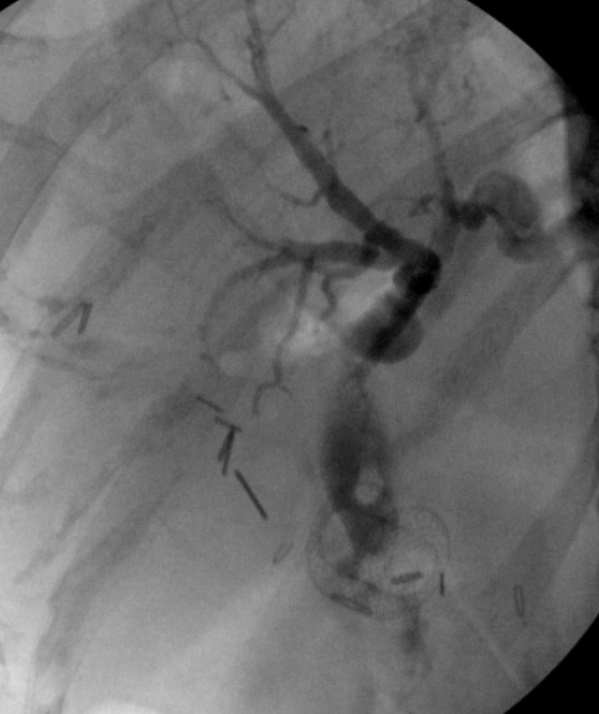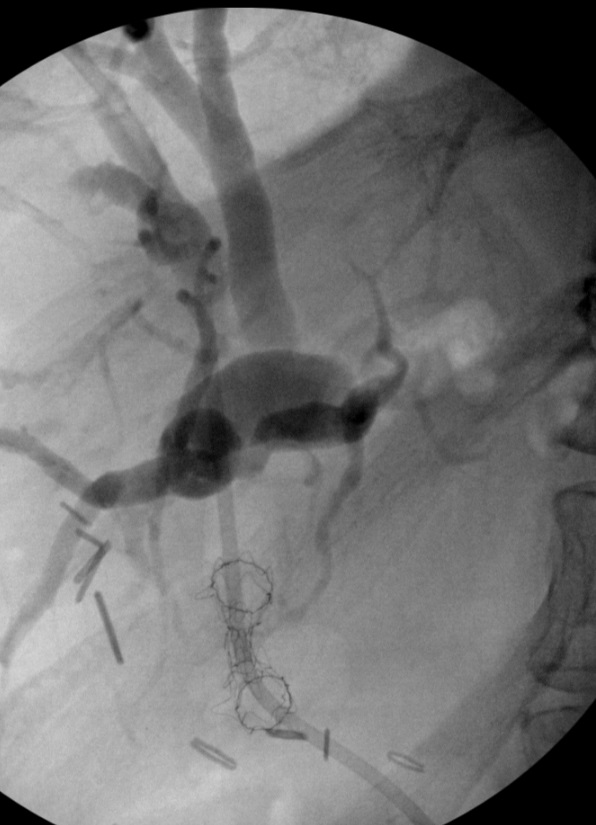Sunday Poster Session
Category: Interventional Endoscopy
P1460 - Combined Use of Fully Covered Self Expandable Metal Stent (FCSEMS) and Double Pigtail Plastic Stent (DPPS) as a Rescue Therapy for Stent Migration Following EUS-Guided Choledochoduodenostomy (EUS-CDS)
Sunday, October 26, 2025
3:30 PM - 7:00 PM PDT
Location: Exhibit Hall
- OL
Oliver Lee, DO
Brooke Army Medical Center
San Antonio, TX
Presenting Author(s)
Oliver Lee, DO, Jerome C. Edelson, MD
Brooke Army Medical Center, San Antonio, TX
Introduction: Endoscopic Ultrasound-Guided Choledochoduodenostomy (EUS-CDS) is an alternative to Endoscopic Retrograde Cholangiopancreatography (ERCP) in patients with surgically altered anatomy. In these cases, EUS-CDS has high technical (93.3%) and clinical (96.2%) success rates for biliary drainage. The advantage over percutaneous drainage includes avoidance of external drains and single-session intervention. Complications include stent migration occurring in 2-3% of cases, and mortality in ~1%. Prompt recognition and endoscopic rescue are critical to minimizing morbidity and the need for external biliary drainage.
Case Description/
Methods: A 62-year-old female with metastatic pancreatic adenocarcinoma and prior palliative Roux-en-Y hepaticojejunostomy and gastrojejunostomy for biliary and duodenal obstruction presented to our hospital with signs of cholangitis. Imaging revealed a 14mm CBD with ductal wall hyperenhancement. ERCP was attempted through the hepatobiliary limb but was unsuccessful as she had afferent limb syndrome. EUS-CDS was subsequently performed. Using a curvilinear echoendoscope, the CBD was identified. An electrocautery-enhanced lumen-opposing metal stent (LAMS) was placed in the CBD. Drainage of bile and contrast and endoscopic visualization of biliary epithelium confirmed placement. The patient returned 4 days after discharge with signs of cholangitis. Radiograph revealed pneumobilia and migrated LAMS in the duodenal bulb. The LAMS was removed using a grasper, and EUS-CDS tract was accessed with an angled-tip wire via a swing-tip cannula. Contrast was injected and a cholangiogram confirmed biliary access. A 4 mm balloon dilator was used to dilate the tract and a 10 mm x 40 mm Fully-Covered Self-Expanding Metal Stent (FCSEMS) was deployed successfully. A double pigtail plastic stent (DPPS) was placed within the FCSEMS anchor the stent and prevent migration. Following ERCP, the patient improved clinically and her liver associated enzymes downtrended, She was discharged home.
Discussion: We demonstrated successful use of FCSEMS combined with double pigtail stent as an endoscopic rescue therapy for stent migration following EUS-CDS. Stent migration is an uncommon adverse event associated with CDS. Despite migration of the stent out of the CBD, many of these cases can be managed endoscopically, minimizing the need for external biliary drainage.

Figure: Cholangiogram demonstrating a successful EUS-guided choledochoduodenostomy using lumen-apposing metal stent (LAMS)

Figure: A successful deployment of 10mm x 40mm fully-covered self-expandable metal stent (FCSEMS) combined with 7 Fr x 10 cm double pigtail plastic stent (DPPS) through choledochoduodenostomy tract
Disclosures:
Oliver Lee indicated no relevant financial relationships.
Jerome Edelson indicated no relevant financial relationships.
Oliver Lee, DO, Jerome C. Edelson, MD. P1460 - Combined Use of Fully Covered Self Expandable Metal Stent (FCSEMS) and Double Pigtail Plastic Stent (DPPS) as a Rescue Therapy for Stent Migration Following EUS-Guided Choledochoduodenostomy (EUS-CDS), ACG 2025 Annual Scientific Meeting Abstracts. Phoenix, AZ: American College of Gastroenterology.
Brooke Army Medical Center, San Antonio, TX
Introduction: Endoscopic Ultrasound-Guided Choledochoduodenostomy (EUS-CDS) is an alternative to Endoscopic Retrograde Cholangiopancreatography (ERCP) in patients with surgically altered anatomy. In these cases, EUS-CDS has high technical (93.3%) and clinical (96.2%) success rates for biliary drainage. The advantage over percutaneous drainage includes avoidance of external drains and single-session intervention. Complications include stent migration occurring in 2-3% of cases, and mortality in ~1%. Prompt recognition and endoscopic rescue are critical to minimizing morbidity and the need for external biliary drainage.
Case Description/
Methods: A 62-year-old female with metastatic pancreatic adenocarcinoma and prior palliative Roux-en-Y hepaticojejunostomy and gastrojejunostomy for biliary and duodenal obstruction presented to our hospital with signs of cholangitis. Imaging revealed a 14mm CBD with ductal wall hyperenhancement. ERCP was attempted through the hepatobiliary limb but was unsuccessful as she had afferent limb syndrome. EUS-CDS was subsequently performed. Using a curvilinear echoendoscope, the CBD was identified. An electrocautery-enhanced lumen-opposing metal stent (LAMS) was placed in the CBD. Drainage of bile and contrast and endoscopic visualization of biliary epithelium confirmed placement. The patient returned 4 days after discharge with signs of cholangitis. Radiograph revealed pneumobilia and migrated LAMS in the duodenal bulb. The LAMS was removed using a grasper, and EUS-CDS tract was accessed with an angled-tip wire via a swing-tip cannula. Contrast was injected and a cholangiogram confirmed biliary access. A 4 mm balloon dilator was used to dilate the tract and a 10 mm x 40 mm Fully-Covered Self-Expanding Metal Stent (FCSEMS) was deployed successfully. A double pigtail plastic stent (DPPS) was placed within the FCSEMS anchor the stent and prevent migration. Following ERCP, the patient improved clinically and her liver associated enzymes downtrended, She was discharged home.
Discussion: We demonstrated successful use of FCSEMS combined with double pigtail stent as an endoscopic rescue therapy for stent migration following EUS-CDS. Stent migration is an uncommon adverse event associated with CDS. Despite migration of the stent out of the CBD, many of these cases can be managed endoscopically, minimizing the need for external biliary drainage.

Figure: Cholangiogram demonstrating a successful EUS-guided choledochoduodenostomy using lumen-apposing metal stent (LAMS)

Figure: A successful deployment of 10mm x 40mm fully-covered self-expandable metal stent (FCSEMS) combined with 7 Fr x 10 cm double pigtail plastic stent (DPPS) through choledochoduodenostomy tract
Disclosures:
Oliver Lee indicated no relevant financial relationships.
Jerome Edelson indicated no relevant financial relationships.
Oliver Lee, DO, Jerome C. Edelson, MD. P1460 - Combined Use of Fully Covered Self Expandable Metal Stent (FCSEMS) and Double Pigtail Plastic Stent (DPPS) as a Rescue Therapy for Stent Migration Following EUS-Guided Choledochoduodenostomy (EUS-CDS), ACG 2025 Annual Scientific Meeting Abstracts. Phoenix, AZ: American College of Gastroenterology.
